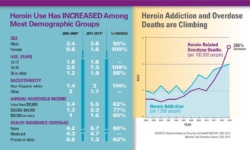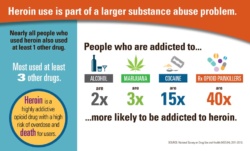If you enter any of the following words, ‘heroin’ ‘opioid’’ ‘addiction’ or ‘epidemic’ into Google the search results that come back at you are truly terrifying. News stories, headline after headline, story after story tell us of lives lost, families destroyed, and communities in utter distress. The heroin epidemic is very real, it is not a piece of sensationalistic media coverage, it is not scaremongering, it is a reality for many Americans in the present day. Heroin addiction is a modern day issue and one we must all care about, it’s no longer class defined or considered an issue only affecting “poor” people, impoverished neighbourhoods or deprived cities. It has become an issue facing every pretty little town across this country. It is an addiction of increasing magnitude in suburban towns and it requires acknowledgement, awareness, understanding and action. It’s time that instead of just talking about it that we extensively explore why this is happening and take whatever measures necessary to stop this horrific epidemic once and for all.

Some believe that the media portrayal of the “heroin epidemic” is scaremongering and simply for publicity purposes. In some instances certain media outlets are irresponsible in their reporting and twist the truth to achieve a grabbing headline. However the facts are very clear, opioids are being severely abused and for most who become addicted to heroin it begins with opioids in the form of commonly prescribed pain medications. While not all overdose deaths are specific to heroin, statistics from 2014 show that more than 28,000 people died from an opioid overdose. For those who minimize the the rise of heroin addiction the figures are clear, with heroin related deaths increasing three fold since 2010 and quadrupling between the years 2002- 2013. The death rate due to heroin related use or overdose was 8,200 in 2013 and this rose to 10,500 in the year 2014. The situation is worsening year on year, state by state and each and everyone one of us are at risk.
According to the Center for Disease Control there are specific categories of people who are most at risk of heroin addiction. The possibility of slotting into one of these categories is extremely high, making the potential risk open to most of the population.
Who is most at risk of heroin addiction?
- People who are addicted to prescription opioid painkillers
- People who are addicted to cocaine
- People without insurance or enrolled in Medicaid
- Non-Hispanic whites
- Males
- People who are addicted to marijuana and alcohol
- People living in a large metropolitan area
- 18 to 25 year olds

It is obvious from the infographic that generally people do not start with heroin as their drug of choice, it is a secondary drug. People who are addicted to other drugs are more likely to use heroin, become addicted and sadly overdose or die as a result of use. The drug/s most associated with heroin are opioid painkillers; potent and highly addictive painkillers are paving the way to heroin addiction in the majority of cases. This is a factor in why the heroin addiction has spread to suburban towns and is no longer stereotypically attributed to people living in poverty. Many who are using heroin got to that point because of an injury, joint or muscle problem etc. The use of potent medication for such conditions is common and these opioids are in many cases being prescribed liberally by physicians. The commonality and frequency of opioid use is increasing our level of vulnerability to use and ultimately become addicted to heroin. You may be thinking this is not a valid explanation, why would someone take heroin if they are addicted to a pain pill? How does someone make the transition from a legally prescribed pain reliever to an illegal narcotic? It comes down to money and the fact that a hit of heroin can be purchased for as little as $3 but pills can cost up to and above $50. Many people cannot afford to feed their prescription drug habit so they turn to the cheaper alternative. Prescription medication is also much harder to obtain after several government measures to tackle the issue of opioid abuse. These well intentioned measures created a whole new problem, with thousands turning to heroin. The statistics are truly frightening with 4.2 million Americans reporting to have used heroin at least once in their lives and an estimated 23% addicted to the drug. Groups that were once perceived as immune from this threat are now experiencing the greatest increases in use; these include women, the privately insured and people with higher incomes.
Still not convinced that an ordinary man or woman in an affluent area, with a good education, good job, a family and no major difficulties to speak of can become a heroin addict? A recent story in The Guardian outlined the life of a young man from Connecticut who had a bright future ahead of him but recovery from a routine surgery dulled this bright future and led him on a very different path. A devastated mother told the story of her son Christopher, how he was the love of her life and her best friend but that because of heroin addiction he “became a different person and didn’t even care”. After 33 years of life, 15 years of addiction, 22 admissions to rehab and five overdoses Christopher died after an accidental overdose at a sober house. Another article “How the middle class got addicted” demonstrates just how common the problem is becoming in seemingly “regular” or “normal” families. We see a range of people talking about the epidemic and the effects, who are themselves shocked that they are in this position. One father told of his son Zachary, a high scoring high school hockey forward who sprained his ankle. This minor non life threatening injury for which he took a pill for the pain led him to heroin. He struggled with recovery and his parents spent tens of thousands of dollars in an effort to save him. In 2013 he celebrated 60 days of sobriety while at a sober-living house but the next day he relapsed, overdosed and died; he was 21 years of age. These are just two examples that demonstrate how easy it is to become an addict, how vulnerable we all are due to the potency and accessibility of medication available to us.
A recent documentary Heroin: Cape Cod, USA highlights the severity of the epidemic in the quaint seaside destination that at first glance couldn’t be seen as further from a heroin engulfed community. The documentary explores the issue looking specifically at the lives of eight young heroin addicts, giving viewers an insight into the harrowing existence of addiction, recovery and relapse. The area of Falmouth where some of the documentary is shot has a staggering heroin death rate of four people per day. Director Steven Okazaki said that while completing the documentary “there were very few people in Massachusetts who didn’t have a connection to the crisis”. This idyllic island is being ravaged by heroin, with participants of the documentary claiming that “you either work or do drugs”. This claim is well-founded when you consider that 85% of crimes on Cape Cod are opiate related. The drug has crossed all lines and perceptions and is making it’s way into every home across the US. Users are more diverse than ever with use growing among white people, women, the middle classes, in the suburbs and particularly across the Midwest and Northeast. The impervious towns of Maine and New Hampshire and suburbs all over the country are now faced with a heroin epidemic, something they would never have dreamed of. Families and parents are genuinely stunned and utterly dismayed at where they are at, instead of taking their sons and daughters to games and after school clubs they are now sitting at families of addicts meetings looking for ways to cope with their child’s addiction.
Some put the epidemic down to use of prescription drugs, others attribute it to the profit driven health system, or to the culture of pill popping for every ache and pain, and some to a lack of regulation and accountability. Realistically it is most probable that it is a combination of all of these. Middle classes can afford health care, they can afford top quality medication and accessing prescription drugs is no real issue. That is until you need more and more and you are running out of funds fast, that’s where cheap and easy to obtain heroin comes in. In just one brief moment you go from being a regular middle class kid to being a junkie. This is the inconceivable reality of America’s suburbs today and unless a genuine and dedicated effort is made to address the source of this epidemic it will grow to a point of a national emergency. Our government must take measures to ensure accountability and responsibility with respect to prescription medication or the tide of heroin addiction will continue to rise and this “Suburban Legend” will become too palpable to ignore.
References:
http://www.hhs.gov/opioids/about-the-epidemic/index.html
http://www.cdc.gov/vitalsigns/heroin/index.html
